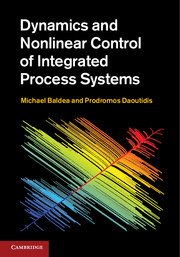7 - Process systems with high energy throughput
from Part III - Process systems with energy integration
Published online by Cambridge University Press: 05 September 2012
Summary
Introduction
In this chapter we will expand the analysis presented in Chapter 6 by considering processes in which significant external energy sources and/or sinks are present. Examples include multiple-effect evaporators (Seider et al. 1999), stand-alone distillation columns and distillation column trains (Jogwar and Daoutidis 2010), and exothermic reactors with external heat exchanger (Baldea and Daoutidis 2006). Understanding the energy dynamics of such processes is beneficial both from a control point of view and from an economic point of view, given today's rising energy and utility costs. We will follow the results in (Baldea and Daoutidis 2006) and (Baldea and Daoutidis 2008), and show that the variables that pertain to the energy balance of such processes evolve in a faster time scale than the variables in the material-balance equations. Subsequently, we investigate the impact of this dynamic feature on controller design and demonstrate that the control of process systems with high energy throughput requires several tiers of control action. Specifically, the variables in the energy balance should be controlled in the fast time scale (over a short time horizon) and control objectives related to the material balance should be fulfilled in the slow time scale(s).
Modeling of process systems with high energy throughput
We consider the process system in Figure 7.1, featuring N process units in series. The first unit exchanges energy with the environment at a rate H0 + Qin, with Ho being associated with the inlet material stream of the process and Qin corresponding to an energy source.
- Type
- Chapter
- Information
- Dynamics and Nonlinear Control of Integrated Process Systems , pp. 177 - 220Publisher: Cambridge University PressPrint publication year: 2012



